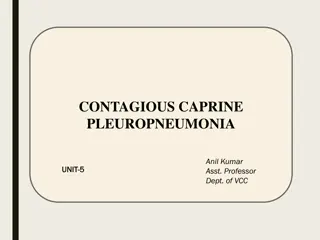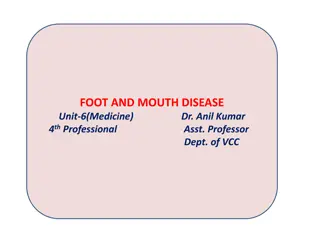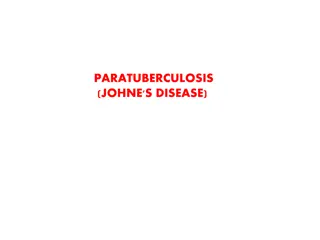Understanding Glanders: A Contagious Bacterial Disease in Animals
Glanders is a contagious bacterial disease primarily affecting equidae but can also infect other animals, including humans. Caused by Burkholderia mallei, it has a historical occurrence and poses risks globally due to its transmission potential. The etiology, survival characteristics, host range, and past occurrences highlight the significance and challenges associated with managing this zoonotic disease.
Download Presentation

Please find below an Image/Link to download the presentation.
The content on the website is provided AS IS for your information and personal use only. It may not be sold, licensed, or shared on other websites without obtaining consent from the author. Download presentation by click this link. If you encounter any issues during the download, it is possible that the publisher has removed the file from their server.
E N D
Presentation Transcript
Veterinary Epidemiology & Zoonoses VPH-321 (Credit Hours-2+1)
Glanders is a contagious bacterial disease affecting primarily equidae (horses, mules and donkeys) and is caused by the bacterium Burkholderia mallei. Cats, dogs, goats, camels and bears can also be affected and most importantly, humans can become infected by contact with infected animals Also K/as: Farcy, *Malleus, Morve, Muermo, cutaneous glanders, equine nasel phthisis, maliasmus *Malleus Gr. malleus, malignant disease
Etiology Caused by- Burkholderia mallei (Previously K/as Pseudomonas mallei) Family -Burkholderiaceae Gram negative, Non-motile, Non-encapsulated and non-spore-forming bacillus Evolutionarily related to the agent of melioidosis (Burkholderia pseudomallei) Can be kill by: UV radiation, Heating at 55oC/10 min. Sun light for 24 h. Susceptible to common disinfectant: Iodine, mercuric chloride in alcohol, potassium permanganate, benzalkonium chloride (1/2000), sodium hypochlorite (500 ppm available chlorine), 70% ethanol, 2% glutaraldehyde, less susceptible to phenolic disinfectants Survivability: Contaminated environment- 6 weeks to months Viable in tap water for at least 1 months Polysaccharide capsule of bacterium is considered an important virulence factor and enhances survival
Occurrence In post World War I era, glanders remained a serious problem in the USSR. During world war II, it emerged as a military problem on the eastern front and in the Balkans, and was reintroduced into central Europe including Germany. It was endemic in Chinese horses and affected 30% ponies. At present, glanders is prevalent in Mongolian horses. In Asia, it is said to cause high morbidity but low mortality in endemic areas. The disease appears to be eradicated from Americas, Australia, and most of the European countries including USSR. In India, the earliest traceable record of glanders dates back to 1881
Occurrence In man Dr. Sainbel - the first principal of London veterinary College in 1723 was one of the first reported human cases of glanders. In India, information on human glanders is scanty despite many reported cases of disease in equines. Dr. S.H. Gaiger (1913-1916), a veterinary pathologist at Punjab Veterinary College, Lahore who contracted the disease while autopsying an infected horse
Host range Animals Equidae (horses, mules and donkey), occasionally Felidae, and other species are susceptible; Donkeys are most susceptible, mules somewhat less and horses demonstrate some resistance manifested in chronic forms of the disease, especially in endemic areas Susceptibility also seen in in camels, bears, wolves and dogs Carnivores may become infected by eating infected meat Cattle and pigs are resistant Small ruminants may also be infected if kept in close contact to glanderous horses Human: Veterinarians, Butchers, Groom, lab workers, Horse handlers
Transmission The bacteria transmitted to humans Contact with tissues or body fluids of infected animals The bacteria enter the body through cuts or abrasions in the skin Through mucosal surfaces such as the eyes and nose Inhaled via infected aerosols or dust contaminated by infected animals Cases of human-to-human transmission have not been reported In animals Direct horse to horse contact also plays a part in transmission between horses with active skin lesions and discharging lymph nodes
Sign and Symptoms In Animals The course of disease as: Acute (usually associated with donkeys) or assess and mules Chronic (associated with horses in endemic areas) Acute form: High fever, depression, dyspnea, diarrhea & rapid weight loss. Chronic form: Nasel form Pulmonary form Cutaneous form
Sign and Symptoms In Animals Nasal form (Nasal glanders) Ulceration of mucosa: one or both the nostril, larynx & trachea Ulcers have: Grayish center with thick, jagged borders (star shaped) A highly infectious, viscous, yellowish-green, mucopurulent discharge is present and this may crust around the nares A purulent ocular discharge Regional lymph nodes (e.g. submaxillary) are enlarged and indurated and may rupture and suppurate; these often will adhere within deeper tissues Nodules and ulcers in the nasal conchae in a horse with glanders at PM Nasal discharge in donkey Mucopurulent nasal discharge in horse
Sign and Symptoms In Animals Pulmonary form (Pulmonary glanders) Usually requires several months to develop; first manifestation: Intermittent fever, dyspnoea, paroxysmal coughing or a persistent dry cough accompanied by laboured breathing Diarrhoea and polyuria: Progressive loss of condition Nodules: Grayish white with red border, Later become calcified & discharge their contents spreading the disease to the upper respiratory tract Surrounded by: grayish, granulated or white fibers Occasionally, lesions observed in the liver, spleen & kidneys Black miliary granulomas (nodules) found in the lung postmortem in a horse with glanders
Sign and Symptoms In Animals Cutaneous form (Cutaneous glanders) This form is also referred to as farcy . Develops insidiously over an extended period; begins with fever, coughing, enlargement of the lymph nodes, dyspnoea usually associated with periods of exacerbation leading to progressive debilitation Nodules: Gray center & excrete a thick, oily liquid that encrust the hair Nodules appear under the skin along the course of lymphatics of the legs, ribs & belly Leads to persistent ulcers connected along tortuous, thickened lymphatic vessels Upon rupturing: excrete an infectious, purulent discharge
Sign and Symptoms In Human Incubation period-1-14 days to month Acute & Chronic form The disease causes fever, malaise, fatigue, jaundice, nausea, rheumatic pain in legs and headach Erysepelous swelling on face and limbs or painful nodules and phlegemonous inflammation The nodular eruption is followed by pustular eruptions on the skin of face, legs, arms and other body parts The nasal mucosa becomes congested and swollen, and conditions like severe pyaemia, metastatic pneumonia, muscular abscessation and diarrhoea set in leading to emaciation and collapse. In chronic cases, these symptoms last for several days to months
Diagnosis In animals- 1.Physical examination of animals: Cardinal sign and symptoms of disease 2. Mallein test:0.2 ml of mallein (autoclaved whole culture of B. mallei) is injected by intradermal route in the lower eyelid its edge After 24-36 hrs P.I. development of an edema of eyelid, acute conjunctivitis, photophobia with mucous discharge 3. Serological tests Indirect Haemmaglutination test (IHA) Complement fixation test (CFT): 85-95% in accuracy dot ELISA 4. Isolation of the pathogens Isolation from unopened uncontaminated lesions Require pus samples from lung or nasal mucosa Bacteria grow aerobically, media contains glycerol Strict bio-security measures required
Diagnosis 5. Strauss test: Guinea pig Clinical material I/P Pain full swelling of the scrotal sac Painfully enlarged Caseous mass breaks through skin in 7-10 day The Strauss reaction is not specific for glanders and can be provoked by other organisms, therefore B. mallei must be cultured from the infected testes
Diagnosis In Human- 1. 2. 3. 4. 5. 6. History-Contact with suspected material/animal Isolation of organism Strauss test Agglutination test CFT Mallein test
Differential diagnosis As with all transboundary diseases of animals, clinical signs alone do not allow a definitive diagnosis especially in early stages or the latent from of the disease Strangles (Streptococcus equi) Ulcerative lymphangitis (Corynebacterium pseudotuberculosis) Botryomycosis Sporotrichosis (Sprortrix schenkii) Pseudotuberculosis (Yersinia pseudotuberculosis) Epizootic lymphangitis (Histoplasma farciminosum) Horse pox Tuberculosis (Mycobacterium tuberculosis) Trauma and allergy
Prevention and Control In animals 1. Immunization-No vaccines are available 2. Identification and elimination of the foci of infection 3. Surveillance and monitoring of the infected herd a. To identify the clinical and subclinical cases b. To assess the prevalence and incidence of glanders 5. Positive animals should be slaughtered-According to the provision of The Glanders and Farcy Act XIII, 1899 6. Carcass disposal-by Incineration, deep burial and disinfection of premises 7. In contact and exposed animals segregated and rechecked 8. Quarantine 9. Public Education 10. Disease notification
Prevention and Control In man 1. Care should be taken during handling, feeding, dressing, grooming, and autopsying , especially equines 2. Medical care-Human glanders cases should be treated promptly and carefully 3. Disease notification 4. Public education
Treatment In animals The treatment of cases of glanders is not advocated In animals Human cases were treated with autogenous vaccine Mallein and other product of organism Organism is sensitive to Streptomycin, chloramphenicol, and tetracycline























